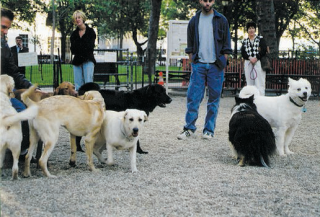Training in the Dog Park

Letting your dog play uninterrupted in the park can be one of the quickest ways to lose control over your adolescent dog. Allow him to play uninterrupted and you'll quickly lose his attention and have no control over him whatsoever. On the other hand, if you integrate training and play, you'll soon develop reliable, off-leash distance control over your dog.
How to Train Your Dog Not to Come When Called
Many owners let their dogs off-leash without so much as a "please" or a "Sit." Often the dogs are excitedly bouncing and barking in anticipation of playing. Thus being let off-leash reinforces their boisterous behavior. They delight in their new-found freedom, running around, sniffing, chasing each other, and playing together like crazy. The owners look on and chat. Eventually, it's time to go. One owner calls her dog, the dog comes running, the owner snaps on the leash, and the play session is over.
This sequence of events is likely to happen just once or twice, because on subsequent trips to the park the dog understandably will not be quite so keen to come to his owner when called. It doesn't take much for the dog to make the association between coming when called and having an otherwise utterly enjoyable romp in the park abruptly terminated. On future trips to the park, the dog approaches his owner slowly with head down. The owner is now doing a fine job demotivating the dog's recall and is inadvertently training the dog not to come when called.
Indeed, slow recalls quickly become no recalls, as the dog tries to prolong his fun by playing Catch-Me-If-You-Can. The irritated owner now screams for the dog to come, "Bad dog! Come here!" And, of course, the dog muses, "I don't think so! In the past I have learned that that nasty tone and volume mean you're not too happy. I think it would be a mite foolish for me to approach you right now. You're not in the best frame of mind to praise and reward me appropriately." But you are not going to do this with your dog, are you?
How to Train Your Dog to Come When Called
Instead, you are going to take your dog's dinner kibble to the park, call your dog every minute or so throughout his play session, have him sit for a couple of pieces of kibble, and then let him go play again. Your dog will soon learn that coming when called is an enjoyable time-out, a little refreshment, a kind word, and a hug from you, before he resumes play. Your dog becomes confident that coming when called does not signal the end of the play session. Your dog's enthusiastic recalls will be the talk of the town! When it is time to end the off-leash play session, I like to soften the blow by telling my dogs, "Let's go and find your Kongs!" Before going to the park, I always leave stuffed Kongs in the car and back home as a special treat.
In addition, you might consider teaching your dog an emergency sit or down, which is often better than an emergency recall. Teaching a reliable sit or down is much easier than maintaining a reliable recall. With a quick sit you instantly control your dog's behavior and limit his movement. Once your dog is sitting, you have several options:
1. You may let the dog resume playing. (Either you were just practicing the emergency sit, or the danger has passed.)
2. You may call your dog to you. (The surroundings are changing and it would be safer if your dog were closer; other dogs, people, or especially children are approaching.) Your dog is more likely to come when called if he is already sitting and looking at you, that is, if he is already demonstrating willing compliance.
3. You may instruct your dog to lie down and stay. (The setting is likely to be unstable for a while and it would be safer if your dog were not running around or running toward you. For example, a group of schoolchildren may be passing between you and your distant dog. To call your dog now would scatter the children like bowling pins.)
4. Walk up to your dog and put him on leash. For added stability, it is good practice to hold your dog's attention with your hand in a policeman stop signal and continually praise your dog for staying as you approach. (Do this when danger is imminent and a recall or distant stay would be unwise. For example, a herd of one hundred goats is being driven towards your dog. This once happened to my Malamute in Tilden Park in Berkeley.)
Adapted from AFTER You Get Your Puppy by Dr. Ian Dunbar




